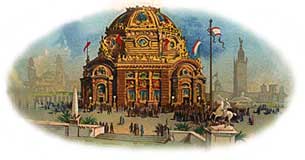

|
 |
One of the most popular buildings at the the Exposition, the Temple of Music was the only one of the temporary buildings whose interior was finished. Situated on a corner directly across from its very similar sister, the Ethnology Building, the Temple of Music was square in shape but truncated corners gave it the appearance of being round. It was 150 feet on each side, the center dome rising to 180 feet outside, 53 feet 9 inches from the floor inside. Designed by Buffalo architect, August Esenwein, it cost $85,000 to construct. Visitors and journalists were of widely differing opinions on whether this most brightly decorated building was beautiful or excessive in adornment and color. All agree that no other building was as ornate in decoration. The basic color was red, "quite pure" according to C.Y.Turner, Director of color; trimmings were in gold and yellow. The panels in the dome were blue-green. See the article for detailed information on the decoration. Sculpture on the building was designed by Isidore Konti (New York). The four major pieces installed above each corner of the building were intended to symbolize the major categories of Music. On the northwest corner was "Heroic Music", showing a bard singing his songs, inspired by a Muse who with one hand was lifting her veil, indicating the past, while with the other she held a wreath of laurels "symbolic of the glorification of the hero". On the northeast corner was "Music of the Dance" which depicted Bacchus, the God of Joy and Wine, playing his flute, while a Bacchant personifying Gaiety and a boy representing Humor danced. The southeast corner was populated by Sacred Music; here St. Cecilia was playing a harp surrounded by angels who were playing and singing. The group symbolized religious ecstacy and emotion. The final group, "Lyric Music" displayed three figures, a youth inspired by Eros, God of Love, singing to a maiden.* The diagram below shows the general layout of the interior. The daily focus of visitors' attention was the 4 p.m. organ solo on the $18,000 Emmonds Howard organ, one of the largest in the country at that time. There was also a stage large enough to accomodate musical ensembles as well as dignitaries who used the building for special events (e.g. Flag Day ceremonies). With floor seating and balconies, the total available seating was 2,200; it was common for all seats to be taken during performances and for other patrons to stand. The building was open even when no performances were scheduled, and visitors would step into the building to sit in the cool space under the great dome, out of the sun and away from the hubbub of the day. (Note: the contract to construct seating for 1,850 was let on February 23, 1901 to the local firm of Randolph McNutt.) Although the building was remembered by many happy visitors as the source of excellent musical entertainment that included the finest organists and soloists in the country as well as ensembles like Sousa's Band and Victor Herbert's, theTemple of Music achieved another kind of immortality on September 6 when President William McKinley was shot there by Leon Czolgosz. The place where McKinley stood shaking hands at the time was immediately marked and served as a magnet for subsequent Exposition visitors. It is indicated below by a red star.
|